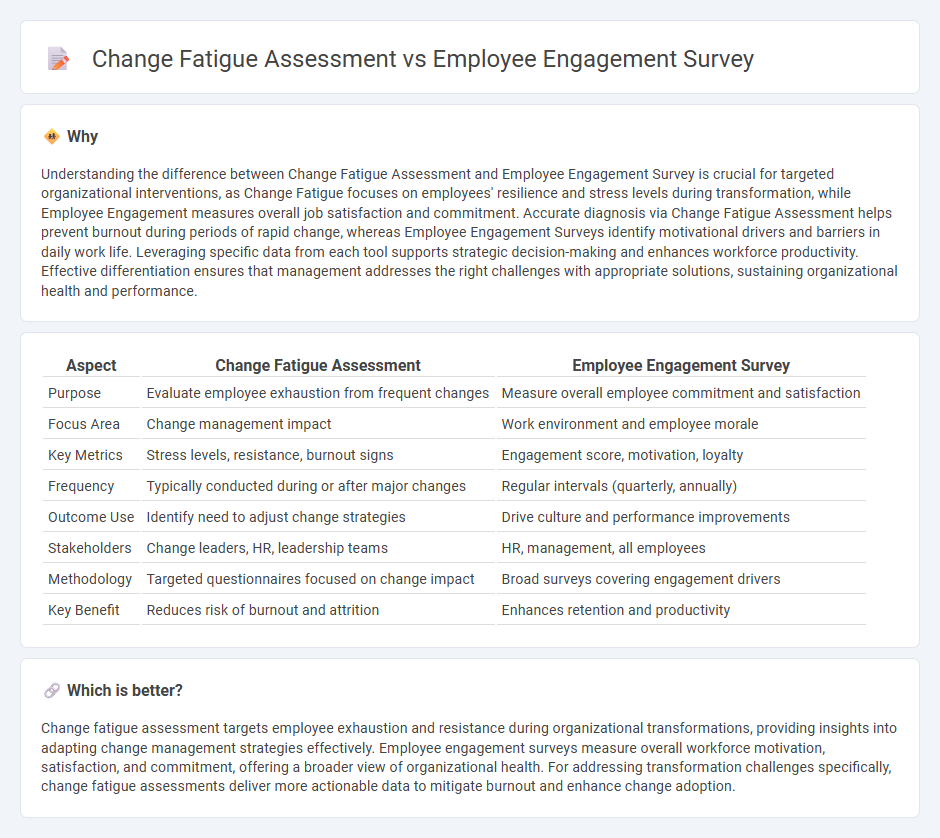
Change fatigue assessment identifies signs of workforce exhaustion due to continuous organizational shifts, focusing on stress levels, resistance to change, and overall adaptability. Employee engagement surveys measure commitment, motivation, and satisfaction, capturing how connected employees feel to their roles and the company's mission. Explore how combining these tools provides deeper insights into employee wellbeing and drives sustainable organizational growth.
Why it is important
Understanding the difference between Change Fatigue Assessment and Employee Engagement Survey is crucial for targeted organizational interventions, as Change Fatigue focuses on employees' resilience and stress levels during transformation, while Employee Engagement measures overall job satisfaction and commitment. Accurate diagnosis via Change Fatigue Assessment helps prevent burnout during periods of rapid change, whereas Employee Engagement Surveys identify motivational drivers and barriers in daily work life. Leveraging specific data from each tool supports strategic decision-making and enhances workforce productivity. Effective differentiation ensures that management addresses the right challenges with appropriate solutions, sustaining organizational health and performance.
Comparison Table
| Aspect | Change Fatigue Assessment | Employee Engagement Survey |
|---|---|---|
| Purpose | Evaluate employee exhaustion from frequent changes | Measure overall employee commitment and satisfaction |
| Focus Area | Change management impact | Work environment and employee morale |
| Key Metrics | Stress levels, resistance, burnout signs | Engagement score, motivation, loyalty |
| Frequency | Typically conducted during or after major changes | Regular intervals (quarterly, annually) |
| Outcome Use | Identify need to adjust change strategies | Drive culture and performance improvements |
| Stakeholders | Change leaders, HR, leadership teams | HR, management, all employees |
| Methodology | Targeted questionnaires focused on change impact | Broad surveys covering engagement drivers |
| Key Benefit | Reduces risk of burnout and attrition | Enhances retention and productivity |
Which is better?
Change fatigue assessment targets employee exhaustion and resistance during organizational transformations, providing insights into adapting change management strategies effectively. Employee engagement surveys measure overall workforce motivation, satisfaction, and commitment, offering a broader view of organizational health. For addressing transformation challenges specifically, change fatigue assessments deliver more actionable data to mitigate burnout and enhance change adoption.
Connection
Change fatigue assessment and employee engagement surveys both measure employee sentiment and organizational health during transformation initiatives. Change fatigue assessment identifies stressors and resistance levels caused by continuous change, while employee engagement surveys evaluate motivation, job satisfaction, and commitment. Together, these tools provide actionable insights to optimize change management strategies and sustain workforce productivity.
Key Terms
Motivation Drivers
Employee engagement surveys primarily evaluate motivation drivers such as recognition, career development, and workplace relationships to enhance productivity and job satisfaction. Change fatigue assessments identify the impact of continuous organizational changes on employees' energy and motivation levels, highlighting stress points that reduce engagement. Explore how combining insights from both approaches can optimize employee motivation and sustain organizational performance.
Burnout Indicators
Employee engagement surveys primarily measure overall job satisfaction and commitment, while change fatigue assessments specifically target stress and exhaustion caused by continuous organizational changes. Burnout indicators such as emotional exhaustion, reduced performance, and depersonalization are more effectively identified through change fatigue assessments that concentrate on the impact of change-related stressors. Explore detailed methodologies to understand how each tool addresses burnout and enhances workforce wellbeing.
Feedback Mechanisms
Employee engagement surveys primarily gather insights on overall job satisfaction, motivation, and workplace culture, while change fatigue assessments specifically measure employee resilience and stress levels amidst ongoing organizational changes. Both tools emphasize feedback mechanisms, utilizing anonymous questionnaires and regular pulse surveys to capture authentic employee sentiments and identify areas needing support. Explore how integrating these feedback strategies can enhance workforce well-being and drive effective change management.
Source and External Links
Employee Engagement Surveys: Ultimate Guide - SurveyMonkey - Provides 24 powerful example questions to address empowerment, team alignment, and organizational growth, highlighting the importance of closing the feedback loop for a healthier company culture.
70 Employee Engagement Survey Questions [+ Free Template] - Offers a comprehensive list of 72 best-practice questions covering work-life balance, manager support, and company culture, and discusses the optimal frequency for running engagement and pulse surveys.
Gallup's Q12 Employee Engagement Survey - Presents the Q12 survey, a globally recognized tool shown to drive higher productivity, profitability, and employee wellbeing, with data linking engagement to key business outcomes.
 dowidth.com
dowidth.com